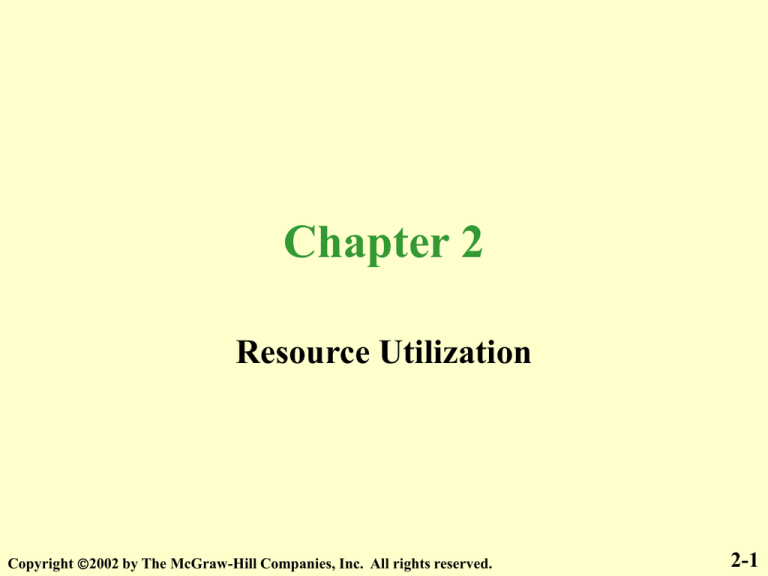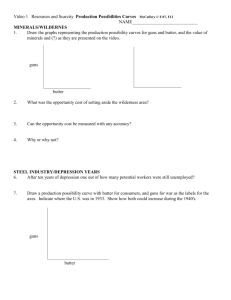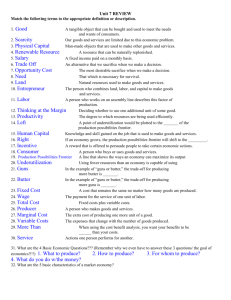
Chapter 2
Resource Utilization
Copyright 2002 by The McGraw-Hill Companies, Inc. All rights reserved.
2-1
Chapter Objectives
•
•
•
•
•
•
•
•
•
Definition of economics
Central fact of economics
The four economic resources
Opportunity cost
Full employment
Full production
Productive and allocative efficiency
Enabling the economy to grow
The law of increasing cost
Copyright 2002 by The McGraw-Hill Companies, Inc. All rights reserved.
2-2
Economics Defined
• Economics is the efficient allocation of
the scarce means of production toward
the satisfaction of human wants
– The means of production are limited
– Human wants are unlimited
Copyright 2002 by The McGraw-Hill Companies, Inc. All rights reserved.
2-3
The Central Fact of Economics Is
SCARCITY
• Scarcity
– Resources are the things society uses to
produce goods and services
• These resources are scarce (limited)
• The economic problem
– There are never enough resources to produce
all of the goods and services that people want
Copyright 2002 by The McGraw-Hill Companies, Inc. All rights reserved.
2-4
Four Economic Resources
•
•
•
•
Land
Labor
Capital
Entrepreneurial ability
Copyright 2002 by The McGraw-Hill Companies, Inc. All rights reserved.
2-5
Land
– Includes natural resources such as
timber, oil, coal, iron ore, soil, water, as
well as the ground in which these
resources are found
– Is used for the extraction of minerals
and farming
– Provides the site for factories, office
buildings, shopping centers, homes, etc.
– Produces “rent”
Copyright 2002 by The McGraw-Hill Companies, Inc. All rights reserved.
2-6
Labor
– The work and time for which one is
paid is what economists call “labor”
– Money received for one’s labor is
called wages and/or salaries
– About two-thirds of the total resource
cost is the cost of labor
Copyright 2002 by The McGraw-Hill Companies, Inc. All rights reserved.
2-7
Capital
– Man-made goods used to produce
other goods or services is what
economists call “capital”
• Examples are office buildings, stores,
and factories
– The money owners of “capital” receive
is called “interest”
– Capital is the MOST important of the
four economic resources
Copyright 2002 by The McGraw-Hill Companies, Inc. All rights reserved.
2-8
Entrepreneurial Ability
• The entrepreneur
–
–
–
–
Sets up a business
Assembles the needed resources
Risks his/her own (or borrowed) money
Makes a “profit” or incurs a “loss”
• Is central to the American economy
– 23 million businesses are virtually all
entrepreneurs
• The vast majority work for themselves or have
one or two employees
Copyright 2002 by The McGraw-Hill Companies, Inc. All rights reserved.
2-9
Our Economic Problem
Revisited
• Limited resources versus unlimited wants
• There are NOT enough resources to
produce everything that everyone wants
• Therefore, CHOICES must BE MADE!
• Every CHOICE has an OPPORTUNITY
COST associated with it!
Copyright 2002 by The McGraw-Hill Companies, Inc. All rights reserved.
2-10
Opportunity Cost: An Important,
Fundamental Concept in Economics
• Because we cannot have everything we
want, we must make choices
• The thing we give up (our second-best
choice) is called the opportunity cost of
our choice
– This is the foregone value of the next best
alternative
• In the economic world, “both” is not an
admissible answer to a choice of “which
one”
Copyright 2002 by The McGraw-Hill Companies, Inc. All rights reserved.
2-11
Highest Valued Alternative
• Options
–
–
–
–
Watch TV
Talk on the telephone
Go on a date
Study economics
Choice made
Highest valued alternative
• The opportunity cost here is the highest valued
alternative that could have been chosen (i.e.,
study economics)
Copyright 2002 by The McGraw-Hill Companies, Inc. All rights reserved.
2-12
Inherit $40,000
Two choices – buy a car or go to college
• Bought the car
• Can’t go to college
– (Paid $40,000)
College graduate (lifetime earnings)
High School graduate (lifetime earnings)
Opportunity Cost
Copyright 2002 by The McGraw-Hill Companies, Inc. All rights reserved.
$1,300,000
800,000
$ 500,000
2-13
California
1967-1997
• Prisons
– Added 21
additional prisons
• Colleges
– Added 1
additional college
The Opportunity Cost of building more
prisons is building fewer colleges
Copyright 2002 by The McGraw-Hill Companies, Inc. All rights reserved.
2-14
California
1990 - 1997
• Prison guards
+ 10,000
• College employees
- 10,000
Obviously, the opportunity cost of one
additional prison is guard is one college
employee
Copyright 2002 by The McGraw-Hill Companies, Inc. All rights reserved.
2-15
Full Employment
• A five percent unemployment rate
1
1 From 1971 – 1996 the unemployment rate was above 5%. In
recent years, this has hovered above 4 %. If it stays this low, the
next edition of the textbook may adjust this to 4 %
Copyright 2002 by The McGraw-Hill Companies, Inc. All rights reserved.
2-16
Full Production
• An eighty-five to ninety percent
utilization rate
Copyright 2002 by The McGraw-Hill Companies, Inc. All rights reserved.
2-17
Underemployment of
Resources
•
•
•
•
•
•
An unemployment rate greater than 5%
A capacity utilization rate less than 85%
Blue laws
Federal and state laws
Night and weekend work
Discrimination
– A phenomenon that has diminished but has not been
eliminated entirely
– Probably keeps our output 10 -15% below what it
could be
• If there was truly an efficient allocation of resources
Copyright 2002 by The McGraw-Hill Companies, Inc. All rights reserved.
2-18
Production Possibilities
Frontier
• Represents our economy at
– Full employment
– Full production
Copyright 2002 by The McGraw-Hill Companies, Inc. All rights reserved.
2-19
Production Possibilities
Curve
16
A
B
14
Hypothetical Production Schedule
Point
Units of Butter Units of Guns
A
15
0
B
14
1
C
12
2
D
9
3
E
5
4
F
0
5
C
12
10
D
8
6
E
4
2
F
0
1
2
3
4
5
6
Units of guns
The Production Possibilities Frontier (PPF) measures the quantity of two
goods that an economy or business is capable of producing with its current
available resources and technology
Copyright 2002 by The McGraw-Hill Companies, Inc. All rights reserved.
2-20
Production Possibilities
Curve
Had to give up 1 unit of butter
16
A
B
14
Hypothetical Production Schedule
Point
Units of Butter Units of Guns
A
15
0
B
14
1
C
12
2
D
9
3
E
5
4
F
0
5
C
12
10
D
8
6
E
4
2
In this particular instance, the opportunity cost
of gaining one unit of guns was one unit of
butter
F
0
1
2
3
4
5
6
Units of guns
To gain 1 unit of Guns
When you are on the line (PPF), to get more of one thing you have to give
up some of the other thing
Copyright 2002 by The McGraw-Hill Companies, Inc. All rights reserved.
2-21
Production Possibilities
Curve
Had to give up 2 units of butter
16
A
B
14
Hypothetical Production Schedule
Point
Units of Butter Units of Guns
A
15
0
B
14
1
C
12
2
D
9
3
E
5
4
F
0
5
C
12
10
D
8
6
E
4
2
In this particular instance, the opportunity cost
of gaining one unit of guns was two units of
butter
F
0
1
2
3
4
5
6
Units of guns
To gain 1 unit of Guns
When you are on the line (PPF), to get more of one thing you have to give
up some of the other thing
Copyright 2002 by The McGraw-Hill Companies, Inc. All rights reserved.
2-22
Production Possibilities
Curve
Had to give up 3 units of butter
16
A
B
14
Hypothetical Production Schedule
Point
Units of Butter Units of Guns
A
15
0
B
14
1
C
12
2
D
9
3
E
5
4
F
0
5
C
12
10
D
8
6
E
4
2
In this particular instance, the opportunity cost
of gaining one unit of guns was three units of
butter
F
0
1
2
3
4
5
6
Units of guns
To gain 1 unit of Guns
When you are on the line (PPF), to get more of one thing you have to give
up some of the other thing
Copyright 2002 by The McGraw-Hill Companies, Inc. All rights reserved.
2-23
Production Possibilities
Curve
Had to give up 4 units of butter
16
A
B
14
Hypothetical Production Schedule
Point
Units of Butter Units of Guns
A
15
0
B
14
1
C
12
2
D
9
3
E
5
4
F
0
5
C
12
10
D
8
6
E
4
2
In this particular instance, the opportunity cost
of gaining one unit of guns was four units of
butter
F
0
1
2
3
4
5
6
Units of guns
To gain 1 unit of Guns
When you are on the line (PPF), to get more of one thing you have to give
up some of the other thing
Copyright 2002 by The McGraw-Hill Companies, Inc. All rights reserved.
2-24
Production Possibilities
Curve
Had to give up 5 units of butter
16
A
B
14
Hypothetical Production Schedule
Point
Units of Butter Units of Guns
A
15
0
B
14
1
C
12
2
D
9
3
E
5
4
F
0
5
C
12
10
D
8
6
E
4
2
In this particular instance, the opportunity cost
of gaining one unit of guns was five units of
butter
F
0
1
2
3
4
5
6
Units of guns
To gain 1 unit of Guns
When you are on the line (PPF), to get more of one thing you have to give
up some of the other thing
Copyright 2002 by The McGraw-Hill Companies, Inc. All rights reserved.
2-25
When you are on the line (PPF), to get more of one thing you have to give
up some of the other thing.
If you were at point G, it would be possible to move to point D or any
other point on the line (PPF) and get more butter and more guns.
When you are at a point that is inside the line (PPF) it is possible to get
more of both.
16
A
B
14
C
12
10
D
8
6
G
E
4
2
F
0
1
2
3
4
5
6
Units of guns
Copyright 2002 by The McGraw-Hill Companies, Inc. All rights reserved.
2-26
Points Inside and Outside the Production Possibilities Curve
Frontier
Point W represents
output at more than full
employment and is
currently unattainable
16
14
A
B
W
C
12
10
Where we usually are
A Recession
A Depression
D
X
8
Y
6
E
Z
4
2
F
0
1
2
3
4
Units of guns
5
6
Every point on the curve represents output at Full Employment
Every point inside the curve represents output at less than Full employment
Copyright 2002 by The McGraw-Hill Companies, Inc. All rights reserved.
2-27
Productive Efficiency
• Is attained when the maximum possible
output of one good is produced, given the
output of other goods
– Productive efficiency occurs only when we are
operating on the production possibilities curve
– Productivity efficiency means that the output of one
good cannot be attained with out reducing the
output of some other good
Copyright 2002 by The McGraw-Hill Companies, Inc. All rights reserved.
2-28
Allocative Efficiency
• When an efficient allocation of resources
is attained, it is not possible to make any
person better off without making
someone else worse off
– No resources are wasted when allocative
efficiency is attained
– No society has ever come close to allocative
efficiency
Copyright 2002 by The McGraw-Hill Companies, Inc. All rights reserved.
2-29
Economic Growth
• Best available technology
• Expansion of labor
– More or better trained labor
• Expansion of capital
– More or improved plant and equipment
Copyright 2002 by The McGraw-Hill Companies, Inc. All rights reserved.
2-30
Economic Growth
• Consumption
– Americans are consuming too much
and producing too little
• In the last 200 years to 1970 the U.S.
economy averaged over 3% growth
annually
• Since 1970 the U.S. Economy has
averaged slightly over 2% growth
annually
Copyright 2002 by The McGraw-Hill Companies, Inc. All rights reserved.
2-31
Economic Growth
• Saving
– Americans are not saving enough
• In the 1960s the savings rate was 6%
• In 1986 the savings rate was 2%
• In 2000 the savings rate was negative
– Business firms are not investing enough
in new plant and equipment
• Private individuals and the federal
government are running up debt
Copyright 2002 by The McGraw-Hill Companies, Inc. All rights reserved.
2-32
Production Possibilities Curves
15
PPC 3
PPC 2
10
PPC 1
5
5
0
10
15
Units of guns
A move from PPC to PPC to PPC represents economic growth
1
2
3
Copyright 2002 by The McGraw-Hill Companies, Inc. All rights reserved.
2-33
Production Possibilities Curves Over Time
Country B
Country A
A.
B.
25
25
20
20
15
15
PPC 2001
10
PPC 2001
10
B
5
0
PPC 1991
PPC 1991
5
A
5
10
Units of consumer goods
15
0
5
10
Units of consumer goods
15
Country A represents slower
economic growth than Country B
Country B represents much faster
economic growth than Country A
Country A capital goods is 3.8 units
Country B capital goods is 7.0 units
Copyright 2002 by The McGraw-Hill Companies, Inc. All rights reserved.
2-34
PPF Practical Application
Saving 10 cents on every dollar earned
could result in the following:
If you start by the time you are around 20 years old
Assume you earn $1,000,000 in your working
lifetime . . . 10% of this is $100,000
Assuming an average of 7% interest annually
this would be worth $385,000 in 30 years. This
means that by the time you are 48-50 years
old, interest on the $385,000 would give you
$26,950 annually ($2,246 a month) for the rest
of your life.
Copyright 2002 by The McGraw-Hill Companies, Inc. All rights reserved.
2-35
Assume you live to be 78-80 years old
30 years times $26, 950 a year would be an
additional income of . . . . . . . . . . $808,500
Plus the initial . . . . . . . . . . . . . . . $385,000
Total additional income . . . . . .$1,193,500
All you would have sacrificed was
NOT spending 10 cents on every
dollar for 30 years.
The opportunity cost of NOT doing
this is approximately $1,193,000
Copyright 2002 by The McGraw-Hill Companies, Inc. All rights reserved.
2-36







